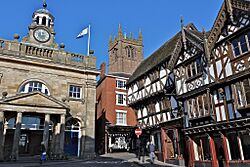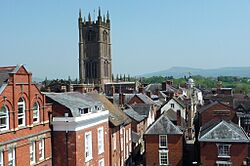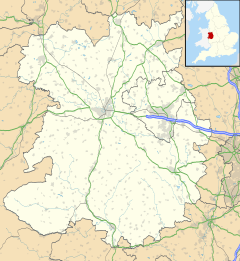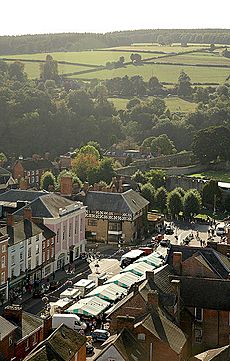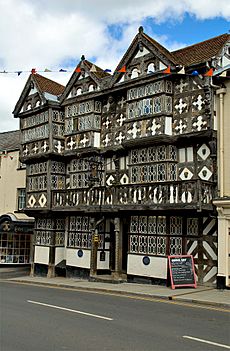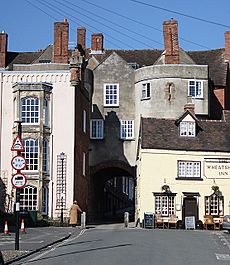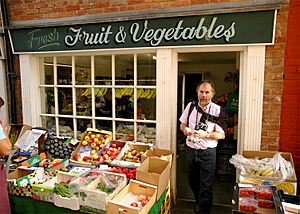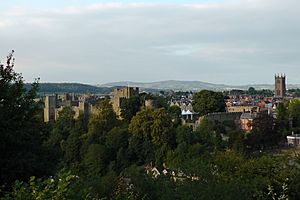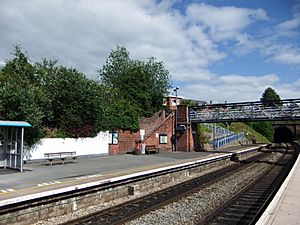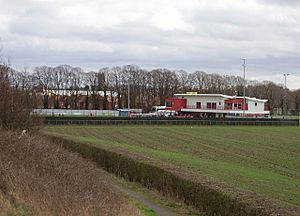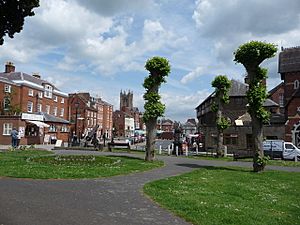Ludlow facts for kids
Quick facts for kids Ludlow |
|
|---|---|
|
Clockwise from top: Junction of Broad Street and King Street, with the Buttercross, Ludlow skyline, St Laurence's Church and Ludlow Castle. |
|
 Coat of arms of Ludlow |
|
| Population | 10,266 (2011) |
| OS grid reference | SO512746 |
| • London | 154 miles (248 km) |
| Civil parish |
|
| Unitary authority |
|
| Ceremonial county | |
| Region | |
| Country | England |
| Sovereign state | United Kingdom |
| Post town | LUDLOW |
| Postcode district | SY8 |
| Dialling code | 01584 |
| Police | West Mercia |
| Fire | Shropshire |
| Ambulance | West Midlands |
| EU Parliament | West Midlands |
| UK Parliament |
|
| Website | www.ludlow.org.uk |
Ludlow is a lively market town and civil parish in Shropshire, England. It's about 28 miles (45 km) south of Shrewsbury and 23 miles (37 km) north of Hereford. The town is built near where the River Corve and River Teme meet.
The oldest part of Ludlow is a medieval walled town. It was started in the late 1000s after the Normans took over England. The town is built on a small hill next to a bend in the River Teme. On this hill, you'll find Ludlow Castle and St Laurence's Church, which is the biggest church in Shropshire. From the hill, the streets go downhill towards the rivers. Ludlow is in a cozy spot, protected by Mortimer Forest and the Clee Hills, which you can easily see from the town.
Ludlow has almost 500 listed buildings. These include amazing Tudor-style buildings with half-timbered walls. Sir John Betjeman, a famous writer, once called Ludlow "probably the loveliest town in England."
Contents
- What's in a Name? The Story of Ludlow
- Ludlow's Long History
- Ludlow's Location and Landscape
- How Many People Live in Ludlow?
- Getting Around Ludlow
- Ludlow's Culture and Fun
- How Ludlow is Governed
- Ludlow's Businesses
- Learning in Ludlow
- Emergency Services in Ludlow
- Places of Worship
- Famous Buildings and Places
- Ludlow's Twin Towns
- Well-Known People from Ludlow
- See also
What's in a Name? The Story of Ludlow
The name Ludlow tells us a lot about the town's past. Before 1138, the area was called Lodelowe. This name comes from old English words: "hlud" meaning "loud waters" and "hlǣw" meaning "hill" or "burial mound."
At that time, the River Teme had fast-flowing rapids, which made a loud noise. So, Ludlow means "a place on a hill by the loud waters." Around the 12th century, weirs (small dams) were added to the river, making the water calmer. The "hill" part refers to the hill the town stands on. There might have also been an ancient burial mound on the eastern side of the hill, which was dug up when St Laurence's church was expanded in 1199.
Interestingly, the town was also known as Dinam for a long time. Ludlow Castle was even called Dinham Castle when it was first built. Some people believe Dinam meant "The Palace of Princes." Today, the Welsh name for Ludlow is Llwydlo.
Ludlow's Long History
Ludlow is very close to Wales and sits near the middle of the long England–Wales border. It's also near the border between Shropshire and Herefordshire. This important location made Ludlow a very significant place in medieval times. It was even the home of the Council of Wales and the Marches from 1472 to 1689.
Medieval Times: Castles and Kings
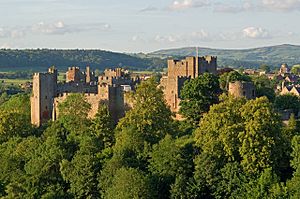
Ludlow Castle was started around 1075 by Roger de Lacy. It was built on a rocky point of the hill. Over time, more parts were added, like the Chapel of St. Mary Magdalene and the Great Tower. The town walls were built later, around the mid-1200s.
The town of Ludlow grew up around the castle. The first main street was along the top of the hill, which is now Castle Square, High Street, and King Street. This wide area became a market place. Other streets like Mill Street and Broad Street were added later.
St Laurence's Church also started in the late 1000s. It was rebuilt and made bigger in 1199-1200. Ludlow was also an early learning center, with two schools around 1200. One of these, Ludlow Grammar School, became Ludlow College much later.
Ludlow Castle was a key fortress along the Welsh Marches, which were the borderlands between England and Wales. It played a big role in many conflicts, like the Wars of the Roses. In the 1400s, the castle became the main base for the Council of Wales and the Marches.
Several Princes of Wales lived here, including King Edward V and Arthur Tudor. Prince Arthur, who was the older brother of Henry VIII, sadly died at Ludlow Castle in 1502.
The town walls were built in the mid-1200s to protect the town. They had four main gates and three smaller ones. Most of the walls are still there today.
A Busy Market Town
Ludlow grew into a busy and wealthy market town. By 1377, about 1,725 people lived there. It was especially known for selling wool and cloth. Many different trades thrived here, with 12 trade guilds in 1372, including metalworkers, shoemakers, and drapers.
The wealth from the wool trade helped build St. Laurence's parish church. It's the largest church in Shropshire and is sometimes called "the cathedral of the Marches" because of its size and beauty.
During the Wars of the Roses, Ludlow Castle was a stronghold for Richard, Duke of York. After the Yorkists won, the castle became property of the King. King Edward IV made Ludlow a borough, which meant it could send people to Parliament. He also set up the Council of Wales and the Marches here in 1472. His son, Edward, Prince of Wales, lived in Ludlow as the head of the council. It was here that the young prince learned he was King Edward V in 1483.

Later, Henry VII also sent his son, Prince Arthur, to Ludlow. Prince Arthur was joined by his wife, Catherine of Aragon. Their time at Ludlow Castle became famous because Catherine later said their marriage was never fully official. This was a big part of why Henry VIII wanted to end his marriage to Catherine later on.
The Council of Wales stayed in Ludlow until 1689. After that, the castle slowly fell apart. People even took stones from it to build other things. Eventually, it was bought by the Earl of Powis, who helped transform the castle grounds.
More Recent Times
In the 1800s, Ludlow was a busy stop for stagecoaches. Many inns, like The Angel on Broad Street, welcomed travelers. The Angel was so important that Horatio Nelson, a famous admiral, stayed there in 1802.
Ludlow was also important for the study of geology. In 1832, a local doctor and geologist, Thomas Lloyd, met with Roderick Murchison to study the rocks near the River Teme. Their work helped explain the Earth's history and led to the naming of the Ludlow Epoch in geology, which is a period of time about 400 million years ago!
In more recent times, Ludlow has become popular for tourism. Many antique shops and art galleries opened. Bodenhams, a clothing shop, has been in business since 1860 in a 600-year-old timber building! Country Life magazine even called Ludlow "the most vibrant small town in England."
Big supermarkets like Tesco and Sainsbury's have also opened on the edge of town. In the 1980s, a computer magazine called Crash was published in Ludlow. It became one of Britain's best-selling computer magazines!
Ludlow's Location and Landscape
Ludlow's old town is mostly on top of a hill. The castle, market place, and St Laurence's Church are on the flatter part of this hilltop. The highest point is at the castle. From there, the streets slope down to the River Teme and River Corve.
The town has grown mostly to the east and northeast. This means the old town center is actually in the southwest corner of the whole settlement. The village of Ludford, just across the Teme, is still a separate community.
Ludlow has been praised by experts for its beautiful old buildings and how well its medieval, Tudor, and Georgian character has been kept. The town's historic setting, with the castle by the River Teme and the surrounding countryside, is still easy to enjoy today.
How Many People Live in Ludlow?
The 2011 UK census showed that 10,266 people lived in Ludlow. If you include the nearby Ludford parish, the population for the town and its close neighbors is about 11,000.
In 1377, Ludlow was the 35th most populated town in England, with 1,172 residents paying a special tax.
| Population growth in Ludlow since 1801 | ||||||||||||||||||
|---|---|---|---|---|---|---|---|---|---|---|---|---|---|---|---|---|---|---|
| Year | 1801 | 1811 | 1821 | 1831 | 1841 | 1851 | 1881 | 1891 | 1901 | 1911 | 1921 | 1931 | 1951 | 1961 | 1971 | 1987 | 2001 | 2011 |
| Population | 3,897 | 4,150 | 4,820 | 5,253 | 5,064 | 4,691 | 5,035 | 4,460 | 4,552 | 5,926 | 5,674 | 5,642 | 6,456 | 6,796 | 7,470 | 7,450 | 9,548 | 10,266 |
| Source: A Vision of Britain through Time and the Office for National Statistics | ||||||||||||||||||
Getting Around Ludlow
Trains
Ludlow railway station opened in 1852 and is a short walk from the town center. You can catch trains here that go to places like Manchester, Shrewsbury, Hereford, and Cardiff. These trains are run by Transport for Wales.
Buses
Bus services connect Ludlow to nearby towns like Church Stretton, Kidderminster, and Shrewsbury. There's also a park and ride service, which helps people get into town without their cars.
Roads
The A49 bypass road was built in the late 1970s to take traffic around Ludlow, making the town center quieter. The old route through town is now called the B4361.
Ludlow's town center still has its narrow medieval streets. Parking can be tricky, so there are special car parks for visitors. The A4117 starts near Ludlow and goes across the Clee Hills.
Two old bridges cross the River Teme in Ludlow: Ludford Bridge and Dinham Bridge. Both still carry cars. To the north, the historic Corve Bridge crosses the River Corve. In 2007, a flood caused the newer Burway Bridge to collapse, but it has since been rebuilt.
Cycling and Walking
National Cycle Network route 44 goes through Ludlow, crossing Dinham and Ludford Bridges. It's part of the Six Castles Cycleway. The Mortimer Trail, a long-distance footpath, also starts in Ludlow and goes to Kington.
Ludlow's Culture and Fun
Festivals and Events
Ludlow used to have a big annual Ludlow Festival with Shakespeare plays and concerts. Sadly, it stopped in 2014. The Medieval Christmas Fayre also used to be a popular event, but it faced challenges and stopped.
Now, the Ludlow Winter Festival has taken its place, starting in 2023.
Food and Drink
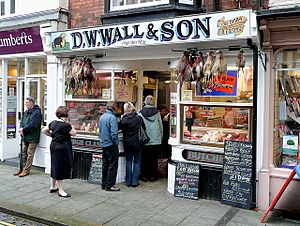
Ludlow is known for its food! It used to have several Michelin-starred restaurants. While those are gone, the town still has three butchers, four bakers, and a regular farmers market. There's even a local brewery that makes real ale using local hops.
The annual Ludlow Marches Festival of Food & Drink is a big event in September. Over 150 local food producers come to Ludlow Castle to show and sell their products. It's a great chance to try local treats!
Arts and Entertainment
The Ludlow Assembly Rooms is an arts and cinema center. It hosts live music, theater, comedy, and shows a variety of films. Ludlow has also been featured in movies and TV shows, like Blott on the Landscape and The History of Tom Jones, a Foundling.
Many famous artists and writers have connections to Ludlow. Poet Alfred Edward Housman, author of "A Shropshire Lad", is buried in St Laurence's Churchyard. The actor John Challis (who played Boycie in Only Fools & Horses) lived near Ludlow, and impressionist Alistair McGowan now lives in the town.
Sports and Activities
Ludlow has a rugby union club and a cricket club. The cricket ground has a lovely view of the castle and St Laurence's Church.
Ludlow Racecourse and Ludlow Golf Club are just outside town. There's also a leisure center with a swimming pool, and clubs for Lawn bowls and amateur boxing.
Local Media
The Ludlow Advertiser newspaper has been published weekly since 1855. You can also find the free Teme Valley Times. For TV news, Ludlow gets signals from BBC West Midlands and ITV Central.
Local radio stations include Sunshine Radio and BBC Radio Shropshire. The Woofferton transmitting station near Ludlow is famous for its Cold War history and is the UK's only remaining shortwave broadcasting site.
How Ludlow is Governed
Ludlow is a civil parish with its own town council and a mayor. The town council works from Ludlow Guildhall on Mill Street, a very old and important building. Another notable civic building is the Buttercross, which used to be a butter market and is now a center for learning about the town's history.
For bigger local decisions, Ludlow is part of Shropshire Council, which is based in Shrewsbury.
Ludlow's Businesses
McConnel Limited, a company that makes machines for cutting hedges and mowing grass, is based in Ludlow. They are known for making the first tractor-mounted hedge cutting machine in 1945.
Market Days
The town has regular outdoor markets in Castle Square. You can find general markets on Mondays, Wednesdays, Fridays, and Saturdays. Special markets for crafts, antiques, and local produce are held on some Thursdays and Sundays.
Learning in Ludlow
Ludlow has two primary schools for children aged 5–11, and a secondary school called the Ludlow Church of England School for students aged 11–16.
Ludlow College is a sixth form college in the town center. It was formed by combining the town's old boys' grammar school and girls' high school. It's one of the oldest educational places in the country, dating back about 800 years!
Emergency Services in Ludlow
The Shropshire Fire and Rescue Service has a fire station in Ludlow with retained firefighters (who are on call). West Mercia Police also has a police station in town. The British Red Cross, a volunteer group that helps people, has a hall in Ludlow too.
Places of Worship
Ludlow has two Church of England churches: the large and historic St Laurence's Church in the town center, and St John's Church. Ludford, a nearby village, has its own church, St Giles.
The Roman Catholic church of St Peter is on Henley Road. It was built in the 1930s with a unique design. Ludlow also has a Methodist church, a Quaker Meeting House, a Baptist church, and an Elim Pentecostal church.
In the past, two monastic institutions (places where monks lived) were in Ludlow, but they were closed down in 1538.
Famous Buildings and Places
Here are some of the most important and historic buildings and structures in Ludlow:
- Ludlow Castle
- St Laurence's Church
- Feathers Hotel
- The Buttercross
- Ludford Bridge
- Horseshoe Weir (a small dam)
- Dinham Bridge
- Castle Lodge
- Reader's House (behind St Laurence's)
- The Broad Gate (one of the old town gates)
- 1 Broad Street (Bodenhams shop)
- St Thomas Chapel, Dinham
- Dinham House & Dinham Lodge
- Hosyers Almshouses (old homes for poor people)
- Palmers Hall, Ludlow College
- The Guildhall
- Old Stone House & Tudor House, Corve Street
- Fishmore Hall Hotel
Ludlow's Twin Towns
Ludlow has special "twinning" agreements with three other towns around the world:
- La Ferté-Macé, France (since 1986)
- San Pietro in Cariano, Italy (since 1989)
- Narberth, Wales (since 2003)
Well-Known People from Ludlow
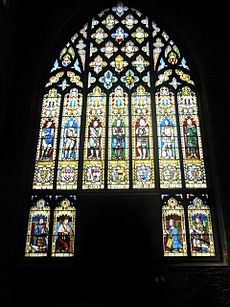
Many interesting people have been connected to Ludlow:
- Thomas Holland (1549–1612) was a scholar who helped translate the King James Version of the Bible.
- Samuel Butler (1613–1680), a famous poet, lived in Ludlow for a time.
- Admiral James Vashon (1742–1827), a distinguished naval officer, lived and is buried in Ludlow.
- Thomas Wright (1810–1877) was an English writer and historian.
- Sir Charles Hastings (1794–1866) was a pioneering doctor who founded the British Medical Association.
- Henry Peach Robinson (1830–1901), a famous photographer, was born in Ludlow.
- Captain Adrian Jones (1845–1938), a well-known sculptor, was born in Ludlow, and his ashes are buried at St Laurence's church.
- Martin Rees, Baron Rees of Ludlow (born 1942), the current Astronomer Royal, grew up near the town.
- The author P. D. James (1920–2014) spent part of her childhood in Ludlow.
- Dick Heckstall-Smith (1934–2004) was an English jazz and blues saxophonist from Ludlow.
- Sheena Porter (born 1935), a British author of children's novels, lives in Ludlow.
- The actor John Challis (1942–2021), famous for playing Boycie in Only Fools & Horses, lived near Ludlow.
- Impressionist Alistair McGowan (born 1964) now lives in Ludlow.
See also
 In Spanish: Ludlow (Shropshire) para niños
In Spanish: Ludlow (Shropshire) para niños


